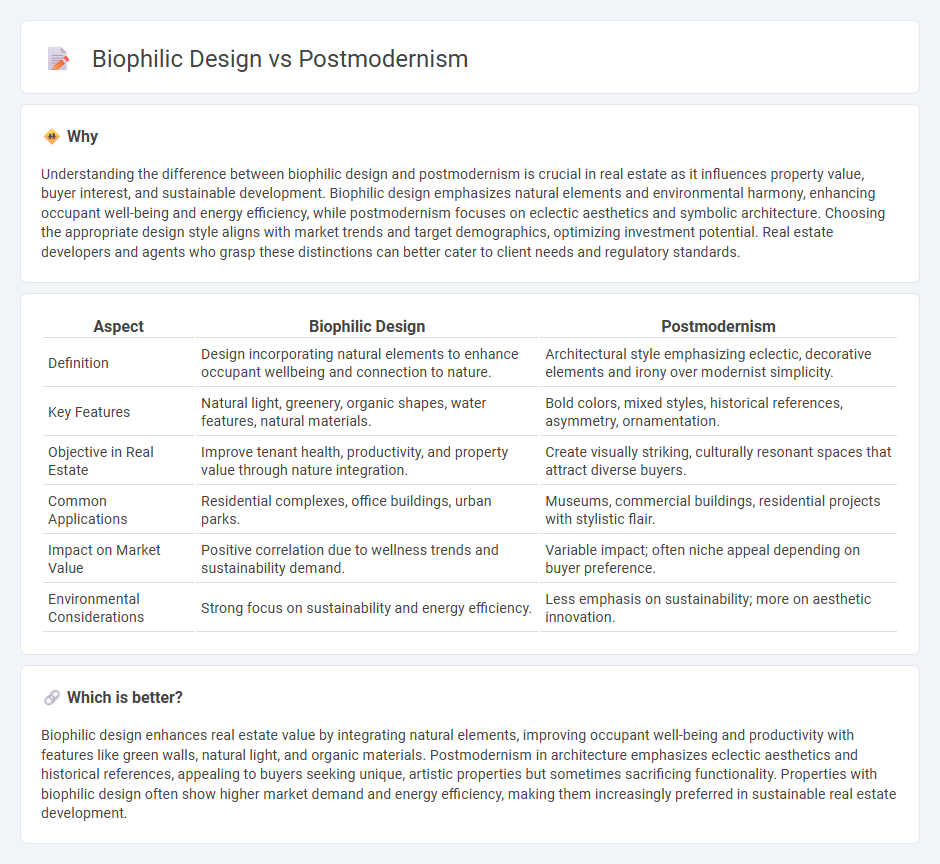
Biophilic design in real estate emphasizes integrating natural elements such as plants, natural light, and organic materials to enhance occupant well-being and create sustainable living environments. Postmodernism in real estate showcases eclectic architecture featuring bold forms, vibrant colors, and historical references that challenge modernist conventions. Discover how these contrasting design philosophies influence property value and lifestyle choices in today's market.
Why it is important
Understanding the difference between biophilic design and postmodernism is crucial in real estate as it influences property value, buyer interest, and sustainable development. Biophilic design emphasizes natural elements and environmental harmony, enhancing occupant well-being and energy efficiency, while postmodernism focuses on eclectic aesthetics and symbolic architecture. Choosing the appropriate design style aligns with market trends and target demographics, optimizing investment potential. Real estate developers and agents who grasp these distinctions can better cater to client needs and regulatory standards.
Comparison Table
| Aspect | Biophilic Design | Postmodernism |
|---|---|---|
| Definition | Design incorporating natural elements to enhance occupant wellbeing and connection to nature. | Architectural style emphasizing eclectic, decorative elements and irony over modernist simplicity. |
| Key Features | Natural light, greenery, organic shapes, water features, natural materials. | Bold colors, mixed styles, historical references, asymmetry, ornamentation. |
| Objective in Real Estate | Improve tenant health, productivity, and property value through nature integration. | Create visually striking, culturally resonant spaces that attract diverse buyers. |
| Common Applications | Residential complexes, office buildings, urban parks. | Museums, commercial buildings, residential projects with stylistic flair. |
| Impact on Market Value | Positive correlation due to wellness trends and sustainability demand. | Variable impact; often niche appeal depending on buyer preference. |
| Environmental Considerations | Strong focus on sustainability and energy efficiency. | Less emphasis on sustainability; more on aesthetic innovation. |
Which is better?
Biophilic design enhances real estate value by integrating natural elements, improving occupant well-being and productivity with features like green walls, natural light, and organic materials. Postmodernism in architecture emphasizes eclectic aesthetics and historical references, appealing to buyers seeking unique, artistic properties but sometimes sacrificing functionality. Properties with biophilic design often show higher market demand and energy efficiency, making them increasingly preferred in sustainable real estate development.
Connection
Biophilic design and Postmodernism intersect in real estate by emphasizing human-centric spaces that merge natural elements with eclectic architectural styles, enhancing occupant well-being and aesthetic diversity. Postmodern architecture's rejection of rigid modernist norms allows the integration of organic forms and greenery, which are central to biophilic principles. This fusion creates innovative environments that boost property value and appeal by fostering emotional connections and sustainable living.
Key Terms
Aesthetic Diversity
Postmodernism celebrates aesthetic diversity through eclectic styles, vibrant colors, and playful forms that challenge traditional design conventions. Biophilic design integrates natural elements like plants, organic materials, and natural light to create harmonious, health-enhancing spaces. Explore how these contrasting approaches redefine aesthetic experiences in contemporary architecture and interiors.
Nature Integration
Postmodernism often critiques conventional aesthetics by embracing eclectic styles and irony, whereas biophilic design centers on integrating natural elements to enhance human well-being and environmental connection. Biophilic design incorporates natural light, vegetation, and organic forms to create spaces that promote health and productivity, contrasting with postmodernism's emphasis on cultural symbolism and fragmented narratives. Explore how merging these approaches could redefine architectural innovation focused on sustainability and human experience.
Human Well-being
Postmodernism, characterized by eclectic styles and skepticism toward grand narratives, often prioritizes aesthetic complexity over occupant comfort and environmental harmony. In contrast, biophilic design integrates natural elements into built environments to enhance human well-being by boosting mental health, reducing stress, and improving cognitive function. Explore how these design philosophies impact human experience and sustainability to optimize future architectural approaches.
Source and External Links
Postmodernism - Wikipedia - Postmodernism is a diverse set of artistic, cultural, and philosophical movements that reject traditional modernist ideas, emphasizing eclectic styles, irony, and cultural pluralism while questioning grand narratives and Enlightenment ideals.
What is Postmodernism? - V&A - Postmodernism in art and design (1970-1990) challenged modernism's clarity and simplicity with complexity, contradiction, theatricality, and a style combining subversion and commercial appeal.
Postmodernism | Internet Encyclopedia of Philosophy - Postmodernism is a philosophical style emerging in the 1960s-70s rejecting modernist values, promoting cultural eclecticism and diversity, challenging elitism, and embracing popular culture and marginalized voices.
 dowidth.com
dowidth.com